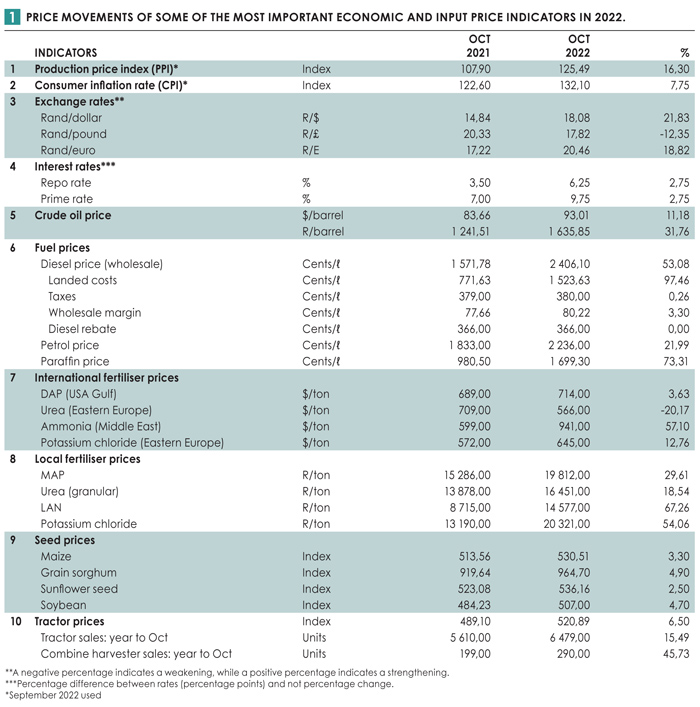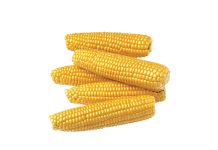
Since 2020, the global economy has been hit by two unexpected and unplanned events. The COVID-19 pandemic caused massive uncertainty in the market, creating unforeseen situations such as oil prices trading in the negative, followed by a strong bullish oil market.
Just when a break from uncertainty was on the horizon, the Russia-Ukraine conflict started creating even more uncertainty, further pushing energy prices to even higher levels – above the previous record levels seen during the 2008 world financial crisis.
The Brent crude oil price increased by 11% in dollar terms from October 2021 to October 2022, following an increase of 102% from October 2020 to October 2021. In rand terms Brent crude oil prices increased by 33% (80% from October 2020 to October 2021). In line with these increases, the diesel price increased by 53% during the same period. Because many of a grain and oilseed producer’s production inputs are affected by energy prices, the increase in crude oil prices has also caused some of the international input prices to increase. On top of that, the rand/dollar exchange rate saw a depreciation of almost 22%, which aggravated already high input prices.
Table 1 shows the price movements of some of the most important economic and input price indicators in 2022.
 Production price index
Production price index
The production price index (PPI) indicates the price increases of goods and services at the wholesale or manufacturing level in the economy. On an annual basis, the PPI rose by 16,3% until September 2022. The PPI for agriculture increased by 13,2% year on year, while the PPI for grain products increased by 32,2%.
Consumer price index
The official inflation rate is calculated based on changes in the consumer price index (CPI) and indicates cost changes at the retail or consumer level. The inflation rate rose by 7,5% year on year in September 2022.
Food inflation rose by 12,3% over the same period. In this basket of food, bread and cereals increased by 19,3%, while meat increased by 9,9%. Oils and fats increased by 29%, while vegetables increased by 10,6% over the same period and fruits decreased by 0,2%.
Exchange rate
In Table 1 a weakening of the value of the rand against other currencies is indicated as a positive change, while a strengthening is shown as a negative percentage change. The rand weakened by 21,8% against the dollar and 18,8% against the euro respectively and strengthened by 12,3% against the British pound from October 2021 to October 2022.
Because South Africa is so dependent on imports of inputs, the weakened rand has further exacerbated the sharp increases experienced in international markets.
Interest rates
During the year until October 2022, the South African Reserve Bank has raised the repo rate to 6,25%, with commercial banks consequently increasing the prime lending rate to 9,75%.
International crude oil prices
As mentioned above, the average Brent crude oil price increased by 102% from $41,39/barrel to $83,66/barrel from October 2020 to October 2021. From October 2021 to October 2022, the price further increased by 11,2% to $93,01/barrel.
In rand terms the crude oil price increased by 31,8% to R1 635,82/barrel on an annual basis until October 2022.
Fuel price
The local wholesale price of diesel in Gauteng increased by 53,1% from R15,72/ℓ in October 2021 to R24,06/ℓ in October 2022.
Over the period of a year, the landed cost of diesel increased by 97,5%, while tax increased by 0,3% and the wholesale margin increased by 3,3%.
The diesel rebate is currently 366 cents/ℓ, consisting of the 218 cents/ℓ of the Road Accident Fund levy and 148 cents/ℓ of the tax component.
International fertiliser prices
The prices of DAP, ammonia and potassium chloride increased by 13,8%, 60,9% and 29% respectively, while urea prices declined by 14% from October 2021 to October 2022.
Local fertiliser prices
Due to South Africa importing more than 80% of its fertiliser needs, local fertiliser prices are exposed to the same factors as in the international market. The average prices of MAP and urea, LAN and potassium chloride increased by 29,6%, 18,5%, 67,3% and 54,1% respectively over a period of one year up to and including October 2022.
Seed prices
Seed accounts for about 10% of a grain and oilseed producer’s current production costs. For the 2021/2022 production season, maize seed increased by an average of 3,3%, grain sorghum seed by 4,9% and sunflower seed by 2,5%. Soybean seed prices increased by 4,7% on an average basis.
Tractor prices
In October 2022, the prices of tractors were 6,5% higher than the corresponding period twelve months ago.
Tractor sales
For 2022, tractor sales up to October increased by 15,5% compared to the same period in 2021. Last year, 5 610 units were sold in this ten-month period, while tractor sales for 2022 stands at 6 479 units.



















